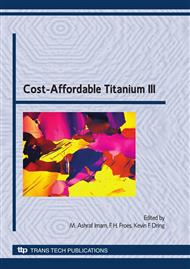p.13
p.27
p.35
p.41
p.55
p.61
p.75
p.85
p.93
A Continuous Process to Produce Titanium Utilizing Metallothermic Chemistry
Abstract:
In the standard Kroll process reaction between the TiCl4 and Mg is at the reactor wall interface that limits the potential to design a continuous process. Many alternatives have been investigated over the past 70 years to engineer a continuous process utilizing metallothermic reduction of TiCl4. Approaches utilizing burner type architectures for continuous processing result in unacceptable very fine Ti powder. A unique process that operates continuously and produces controlled size powder that can be directly utilized in standard powder metallurgy, rapid manufacturing, or substituted for sponge will be discussed.
Info:
Periodical:
Pages:
55-60
Citation:
Online since:
May 2010
Authors:
Price:
Сopyright:
© 2010 Trans Tech Publications Ltd. All Rights Reserved
Share:
Citation:


